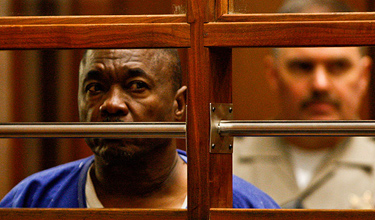
Lonnie David Franklin Jr. appears in Los Angeles County Superior Court in July. (Irfan Khan, Los Angeles Times)
Los Angeles police said Monday they have tentatively identified 21 of the roughly 160 women whose pictures were released last week in an effort to determine whether there were additional victims linked to the alleged Grim Sleeper serial killer.
After identifying the women, police removed their pictures from the LAPD's website. One picture was of Janecia Peters, 25, who was fatally shot on New Year's Day 2007 and was among the victims Lonnie Franklin Jr. has been charged with killing, police said.
The identification of Peters in the group of photos was first reported in the Daily Beast. Members of Peters' family were unable to attend a meeting in which LAPD detectives allowed the victims' relatives to view the pictures before they were made public. Det. Dennis Kilcoyne said the department has since apologized to the family.
Franklin has been linked to Peters through DNA evidence. Other slayings in the three-decade series of killings have been linked through a combination of DNA evidence and ballistics.
Authorities also removed eight other photographs from the website after determining the women pictured were also in other photos.
Kilcoyne said detectives have received nearly 200 tips on the women's identities through phone calls, messages to their tip line and e-mails.
Two of the women whose identities have been confirmed had died of natural causes years ago, police said. Investigators also identified several missing persons in the group of photos and video stills, but Kilcoyne said it was not clear if they were potential victims.
Franklin is accused of sexually assaulting and killing 10 African American women in South L.A. He has pleaded not guilty and is in custody awaiting trial. During his arrest in July, authorities found about 1,000 photographs and hundreds of hours of video footage of women. Some of the images appeared to be innocent snapshots, but many showed the women in various states of undress and in sexual poses.
Detectives feared that some of the women may have been killed and set out to identify them. Some of the material, which was reviewed over the last several months, dated back to the 1980s and included video and digital camera images, Polaroids, conventional prints and undeveloped film.
The decision to release the photos drew criticism from Franklin's attorney, Louisa Pensanti, who said some of the images were of 18 relatives or friends of her client's. She also accused the police of tainting potential jurors.
Prior to releasing the photos, Kilcoyne said detectives asked Franklin's wife to review the images in order to identify family and friends. She declined to help, Kilcoyne said.
Police said they were sensitive to the harm and embarrassment the release of the photographs could cause women who never told their family or friends about the encounters. In the end, however, they decided that the need to identify the women outweighed the potential harm. The Times decided to publish the photographs for similar reasons.











